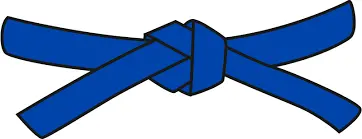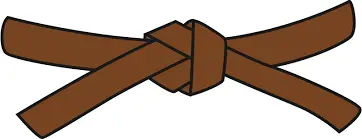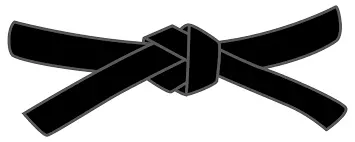What is the Highest Belt in Karate? Ranking System Explained
Karate is a martial art that originated in Okinawa, Japan. Over the long course of history, Karate has gone beyond Japanese cultural borders and is now known worldwide. As it focuses on your personal development, self-defense, and discipline, Karate has a system of colored belts to demonstrate a Karateka’s skill level in Karate.
The highest belt in Karate is the Black belt, also known as Kuro Obi. It has three further divisions, with the 3rd being the highest and highest level of Karate. At this degree, a Karateka becomes qualified to teach Karate and can officially call themselves Sensei.
Apart from visualizing a Karateka’s skill level, the belt symbolizes achievement and self-improvement for the bearers. Further ahead, we will go through the origins of belts in Karate and the levels in this system. So, read until the end and do not miss any details.
Here’s a quick and short table summarizing the belt system in Karate:
| No. | Belt Color | Japanese Name | Represents |
| 1 | White | Shiro Obi | Beginner’s rank, purity, humility |
| 2 | Yellow | Kiiro Obi | Understanding Imporant techniques |
| 3 | Orange | Daidaiiro Obi | Growth and commitment to honing talents |
| 4 | Green | Midori Obi | Deeper connection, maturity in the path |
| 5 | Blue | Aoi Obi | Dedication to refining and awareness |
| 6 | Purple | Murasaki Obi | Progression to a higher ability level |
| 7 | Brown | Chairo Obi | Discipline, experience, commitment to progress |
| 8 | Black | Kuro Obi | Skill mastery, dedication to values and ethics |
Origin of Belts in Karate
To understand why the Karate belt system is important, we need to know a bit about Karate’s history. Karate started in Okinawa, influenced by local fighting styles and Chinese martial arts.
At first, there was no clear ranking system in Karate. People were just known for their skills informally.
Gichin Funakoshi, who helped bring Karate to Japan, introduced the belt system to Karate. He got the idea from Judo’s founder, Master Jigoro Kano. Funakoshi made the belt system popular to show how much a student (Karateka) has learned and grown.
Belts in Karate aren’t just for showing skill. They also motivate students to keep learning and practicing. Each belt represents a student’s hard work and dedication in Karate.
Belt System of Karate
Karate’s belt system is designed to take a student (Karateka) from beginner to master. The belts are different colors and show different levels, called kyu for students and dan for black belts and instructors.
The journey usually starts with the white belt, symbolizing a beginner who is ready to learn. As students improve, they move up through different colored belts, each showing more skill.
The ultimate goal is to earn the black belt, which stands for mastery and years of hard work. In some contexts, the Karate belt system works similarly to the Muay Thai ranking system.
The order of belt colors can be different in various styles of Karate. Here’s a basic order to understand how the colors work:
1. White Belt (Shiro Obi)

The white belt, also known as “Shiro Obi” in Japanese, represents the beginner’s rank and entrance of a person into the core concepts of Karate.
The white belt marks the beginning of a Karateka’s journey, representing purity, humility, and a clean slate ready to get into Karate wisdom.
2. Yellow Belt (Kiiro Obi)

The yellow belt, also known as “Kiiro Obi” in Japanese, represents the level at which the Karateka’s understanding takes root.
The yellow belt represents the first steps in the journey, symbolizing the Karateka’s understanding of essential techniques and principles.
3. Orange Belt (Daidaiiro Obi)

The orange belt, also known as “Daidaiiro Obi” in Japanese, represents growth and a commitment to honing a Karateka’s talents.
The orange belt signifies a degree of advanced development, suggesting that Karatekas are refining their methods and diving deeper into the complexities of Karate.
4. Green Belt (Midori Obi)

The green belt, also known as “Midori Obi” in Japanese, signifies a deeper connection to the art of Karate and a sense of maturity in the Karateka’s path.
The green belt is an intermediate grade, indicating increased technique skill and a deeper understanding of Karate philosophy.
5. Blue Belt (Aoi Obi)

The blue belt, also known as “Aoi Obi” in Japanese, signifies a dedication to further refining and an awareness of karate’s hardness.
Blue belts represent a higher level of expertise, with Karatekas demonstrating an ability to apply techniques and understand the complexities of the discipline.
6. Purple Belt (Murasaki Obi)

The purple belt, known as “Murasaki Obi” in Japanese, represents a progression to a higher ability level and the emergence of individual expression in Karate.
The purple belt is a stage in which Karatekas refine their methods and build a personal style within the context of Karate.
7. Brown Belt (Chairo Obi)

The brown belt, also known as “Chairo Obi” in Japanese, symbolizes discipline, experience, and a commitment to constant progress.
The brown belt represents an advanced level of competency, demonstrating a high degree of talent and a thorough comprehension of Karate principles on behalf of a Karateka.
8. Black Obi (Kuro Obi)

The black belt, known as “Kuro Obi” in Japanese, has rich symbolism, representing not only skill mastery but also a dedication to the values and ethics of karate.
The black belt is the peak of the Karate belt system, representing proficiency and expertise. Black belts are further divided into dan levels, beginning with 1st dan and continuing upwards.
Each belt, with its different color and Japanese name, contributes to the overall development of the Karateka by showing their progress, understanding, and dedication to the art of Karate.
The journey through the belt system symbolizes the essence of karate, combining physical skill, mental discipline, and a firm connection with the tradition and philosophy of Karate.
How do You Achieve a Higher Rank in Karate?
Earning a higher rank in Karate demands dedication, discipline, and a comprehensive approach to training. Here are some tips to help you advance:
1. Commitment to Training
Regular and consistent attendance at karate lessons sets you on the path to progress. Also, Participation in workshops, seminars, and other training opportunities improves skills.
2. Understanding the Curriculum
Each belt level has a curriculum containing techniques, katas, and principles.
A thorough understanding and mastery of the curriculum at each rank is required for your advancement.
3. Mental and Physical Ability
Karate requires both mental and physical power. You should improve your focus, mental resilience, and capacity to remain calm under pressure to advance further in Karate.
4. Seek Guidance from Instructors
Instructors are significant mentors on the path to higher levels. Actively ask for comments, ask questions, and fully engage in the learning process under their supervision to hone your skills in Karate.
5. Participate in Karate Competitions
Tournaments and sparring sessions or competitions help you gain practical experience. Exposure to many styles and techniques improves adaptation and skill development, which ultimately helps you build up the resilience required to master the art of Karate.
Conclusion
The evolution of Karate’s belt system shoes the movement from Okinawan origins to a global phenomenon. As they progress through the ranks, Karatekas develop their techniques and embrace the beliefs and concepts that define Karate as a way of life for them.
Starting on the road to the highest rank in karate, the black belt is a commitment to a lifetime of learning and self-improvement. Aside from the physical methods, it is a journey of self-discovery, endurance, and a high admiration for the art of Karate and its history.
The highest belt in Karate is more than just a rank; it reflects your dedication, discipline, and never-ending pursuit of excellence.
- Related Post: 10 Best Online Martial Arts Training Classes and Courses




